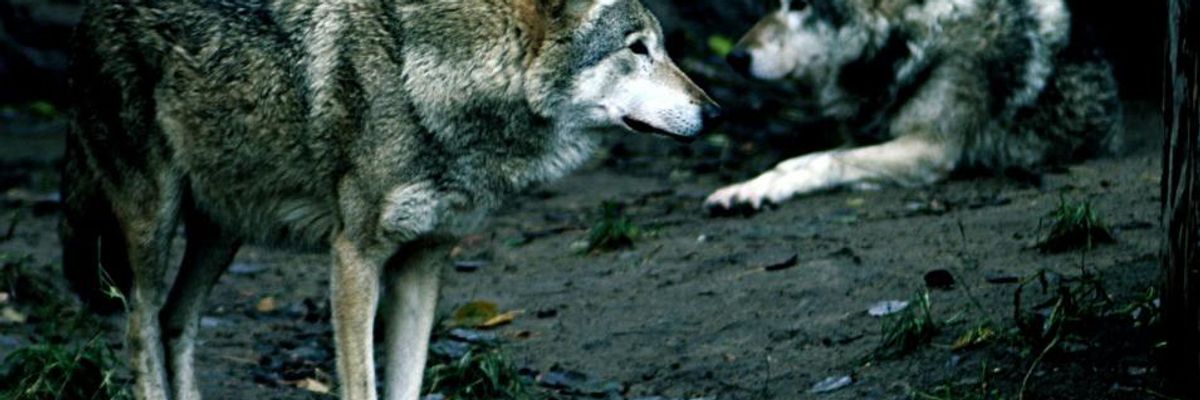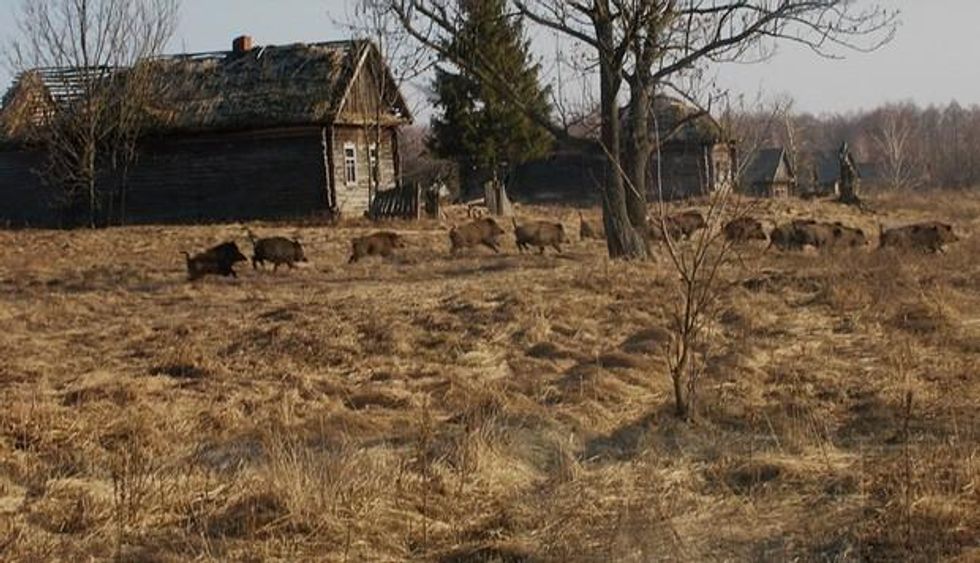

SUBSCRIBE TO OUR FREE NEWSLETTER
Daily news & progressive opinion—funded by the people, not the corporations—delivered straight to your inbox.
5
#000000
#FFFFFF
To donate by check, phone, or other method, see our More Ways to Give page.


Daily news & progressive opinion—funded by the people, not the corporations—delivered straight to your inbox.

(Photo: Photogore / Creative Commons license)
If you think that life for a wild animal would be more horrendous and hazardous inside an "exclusionary zone" in the shadow of a melted-down nuclear plant than living in a world beset with deforestation, hunting and poaching, and the nearly non-stop encroachment of humanity's industrial expansion--a new study may have you thinking twice about such assumptions.
Published in the journal Current Biology on Monday, the new research shows that despite nearly three decades of living within the Belarus sector of the Chernobyl "exclusion" zone, the relative abundances of large mammals--including elk, dear and wild boar--are similar to those in four "uncontaminated" nature reserves in the region. Moreover, the study found, that the population of wolves was more than seven times higher inside the exclusion zone, compared to outside.
"[Our research] doesn't say that nuclear accidents aren't bad, of course they are. But it illustrates that the things we do everyday, the human population pressure, damages the environment. It's kind of obvious but it's an amazing illustration of it." --Prof. Jim Smith, University of PortsmouthAs the Guardian's reporting on the study notes, its findings run counter to previous hypothesises--not to mention everyday common sense--regarding how chronic long-term exposure to radiation might influence animal populations. But as Professor Jim Smith, professor of environmental science at the University of Portsmouth and one of the paper's authors, explained to the Guardian, the research findings do not show that living within a nuclear contamination zone is good, but simply highlights the widespread dangers and downward pressures contemporary society is having on the planet's wild mammal populations.
"What we do, our everyday habitation of an area - agriculture, forestry - they've damaged wildlife more than the world's worst nuclear accident," Smith explained. "It doesn't say that nuclear accidents aren't bad, of course they are. But it illustrates that the things we do everyday, the human population pressure, damages the environment. It's kind of obvious but it's an amazing illustration of it."

In response to Monday's release of the study, two other Chernobyl researchers-- Mike Wood of the University of Salford and Nick Beresford at the Centre for Ecology & Hydrology--wrote to say that though the work of Smith and his colleagues is a vital addition, much more research must be done to better understand the long-term impacts of various species exposed to such radiation. In their post on Gizmodo, Wood and Beresford explained:
While the study has shed much-needed light on wildlife in the area, further research is needed to verify the result and help us understand why this effect is seen.
For example, the finding goes against what may be expected to be seen: that ionising radiation is hazardous to living organisms. The results may even be taken to imply that raised radiation levels may have a beneficial effect on wildlife. However, it is important to keep in mind that as humans have left the zone, there is no agriculture, forestry or hunting to threaten wildlife. So radiation is most likely not good for animals, but removing humans definitely is.
There are likely to be negative effects of radiation in the exclusion zone. But currently we cannot clearly see this over the effects of humans leaving the area. For instance, the health or lifespan of the animals maybe affected and research is required to evaluate this.
Trump and Musk are on an unconstitutional rampage, aiming for virtually every corner of the federal government. These two right-wing billionaires are targeting nurses, scientists, teachers, daycare providers, judges, veterans, air traffic controllers, and nuclear safety inspectors. No one is safe. The food stamps program, Social Security, Medicare, and Medicaid are next. It’s an unprecedented disaster and a five-alarm fire, but there will be a reckoning. The people did not vote for this. The American people do not want this dystopian hellscape that hides behind claims of “efficiency.” Still, in reality, it is all a giveaway to corporate interests and the libertarian dreams of far-right oligarchs like Musk. Common Dreams is playing a vital role by reporting day and night on this orgy of corruption and greed, as well as what everyday people can do to organize and fight back. As a people-powered nonprofit news outlet, we cover issues the corporate media never will, but we can only continue with our readers’ support. |
If you think that life for a wild animal would be more horrendous and hazardous inside an "exclusionary zone" in the shadow of a melted-down nuclear plant than living in a world beset with deforestation, hunting and poaching, and the nearly non-stop encroachment of humanity's industrial expansion--a new study may have you thinking twice about such assumptions.
Published in the journal Current Biology on Monday, the new research shows that despite nearly three decades of living within the Belarus sector of the Chernobyl "exclusion" zone, the relative abundances of large mammals--including elk, dear and wild boar--are similar to those in four "uncontaminated" nature reserves in the region. Moreover, the study found, that the population of wolves was more than seven times higher inside the exclusion zone, compared to outside.
"[Our research] doesn't say that nuclear accidents aren't bad, of course they are. But it illustrates that the things we do everyday, the human population pressure, damages the environment. It's kind of obvious but it's an amazing illustration of it." --Prof. Jim Smith, University of PortsmouthAs the Guardian's reporting on the study notes, its findings run counter to previous hypothesises--not to mention everyday common sense--regarding how chronic long-term exposure to radiation might influence animal populations. But as Professor Jim Smith, professor of environmental science at the University of Portsmouth and one of the paper's authors, explained to the Guardian, the research findings do not show that living within a nuclear contamination zone is good, but simply highlights the widespread dangers and downward pressures contemporary society is having on the planet's wild mammal populations.
"What we do, our everyday habitation of an area - agriculture, forestry - they've damaged wildlife more than the world's worst nuclear accident," Smith explained. "It doesn't say that nuclear accidents aren't bad, of course they are. But it illustrates that the things we do everyday, the human population pressure, damages the environment. It's kind of obvious but it's an amazing illustration of it."

In response to Monday's release of the study, two other Chernobyl researchers-- Mike Wood of the University of Salford and Nick Beresford at the Centre for Ecology & Hydrology--wrote to say that though the work of Smith and his colleagues is a vital addition, much more research must be done to better understand the long-term impacts of various species exposed to such radiation. In their post on Gizmodo, Wood and Beresford explained:
While the study has shed much-needed light on wildlife in the area, further research is needed to verify the result and help us understand why this effect is seen.
For example, the finding goes against what may be expected to be seen: that ionising radiation is hazardous to living organisms. The results may even be taken to imply that raised radiation levels may have a beneficial effect on wildlife. However, it is important to keep in mind that as humans have left the zone, there is no agriculture, forestry or hunting to threaten wildlife. So radiation is most likely not good for animals, but removing humans definitely is.
There are likely to be negative effects of radiation in the exclusion zone. But currently we cannot clearly see this over the effects of humans leaving the area. For instance, the health or lifespan of the animals maybe affected and research is required to evaluate this.
If you think that life for a wild animal would be more horrendous and hazardous inside an "exclusionary zone" in the shadow of a melted-down nuclear plant than living in a world beset with deforestation, hunting and poaching, and the nearly non-stop encroachment of humanity's industrial expansion--a new study may have you thinking twice about such assumptions.
Published in the journal Current Biology on Monday, the new research shows that despite nearly three decades of living within the Belarus sector of the Chernobyl "exclusion" zone, the relative abundances of large mammals--including elk, dear and wild boar--are similar to those in four "uncontaminated" nature reserves in the region. Moreover, the study found, that the population of wolves was more than seven times higher inside the exclusion zone, compared to outside.
"[Our research] doesn't say that nuclear accidents aren't bad, of course they are. But it illustrates that the things we do everyday, the human population pressure, damages the environment. It's kind of obvious but it's an amazing illustration of it." --Prof. Jim Smith, University of PortsmouthAs the Guardian's reporting on the study notes, its findings run counter to previous hypothesises--not to mention everyday common sense--regarding how chronic long-term exposure to radiation might influence animal populations. But as Professor Jim Smith, professor of environmental science at the University of Portsmouth and one of the paper's authors, explained to the Guardian, the research findings do not show that living within a nuclear contamination zone is good, but simply highlights the widespread dangers and downward pressures contemporary society is having on the planet's wild mammal populations.
"What we do, our everyday habitation of an area - agriculture, forestry - they've damaged wildlife more than the world's worst nuclear accident," Smith explained. "It doesn't say that nuclear accidents aren't bad, of course they are. But it illustrates that the things we do everyday, the human population pressure, damages the environment. It's kind of obvious but it's an amazing illustration of it."

In response to Monday's release of the study, two other Chernobyl researchers-- Mike Wood of the University of Salford and Nick Beresford at the Centre for Ecology & Hydrology--wrote to say that though the work of Smith and his colleagues is a vital addition, much more research must be done to better understand the long-term impacts of various species exposed to such radiation. In their post on Gizmodo, Wood and Beresford explained:
While the study has shed much-needed light on wildlife in the area, further research is needed to verify the result and help us understand why this effect is seen.
For example, the finding goes against what may be expected to be seen: that ionising radiation is hazardous to living organisms. The results may even be taken to imply that raised radiation levels may have a beneficial effect on wildlife. However, it is important to keep in mind that as humans have left the zone, there is no agriculture, forestry or hunting to threaten wildlife. So radiation is most likely not good for animals, but removing humans definitely is.
There are likely to be negative effects of radiation in the exclusion zone. But currently we cannot clearly see this over the effects of humans leaving the area. For instance, the health or lifespan of the animals maybe affected and research is required to evaluate this.